
A cactus is a member of the plant family Cactaceae, a family comprising about 127 genera with some 1750 known species of the order Caryophyllales. The word cactus derives, through Latin, from the Ancient Greek word κάκτος (káktos), a name originally used by Theophrastus for a spiny plant whose identity is now not certain. Cacti occur in a wide range of shapes and sizes. They are native to the Americas, ranging from Patagonia in the south to parts of western Canada in the north, with the exception of Rhipsalis baccifera, which is also found in Africa and Sri Lanka. Cacti are adapted to live in very dry environments, including the Atacama Desert, one of the driest places on Earth. Because of this, cacti show many adaptations to conserve water. For example, almost all cacti are succulents, meaning they have thickened, fleshy parts adapted to store water. Unlike many other succulents, the stem is the only part of most cacti where this vital process takes place. Most species of cacti have lost true leaves, retaining only spines, which are highly modified leaves. As well as defending against herbivores, spines help prevent water loss by reducing air flow close to the cactus and providing some shade. In the absence of true leaves, cacti's enlarged stems carry out photosynthesis.

Pinus sylvestris, the Scots pine (UK), Scotch pine (US) or Baltic pine, is a species of tree in the pine family Pinaceae that is native to Eurasia. It can readily be identified by its combination of fairly short, blue-green leaves and orange-red bark.

Cercis canadensis, the eastern redbud, is a large deciduous shrub or small tree, native to eastern North America from southern Michigan south to central Mexico, west to New Mexico. Species thrive as far west as California and as far north as southern Ontario, roughly corresponding to USDA hardiness zone 5b. It is the state tree of Oklahoma.
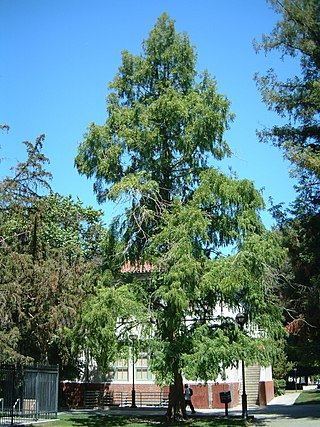
Metasequoia glyptostroboides, the dawn redwood, is a fast-growing, endangered deciduous conifer. It is the sole living species of the genus Metasequoia, one of three genera in the subfamily Sequoioideae of the family Cupressaceae. It now survives only in wet lower slopes and montane river and stream valleys in the border region of Hubei and Hunan provinces and Chongqing municipality in south-central China, notably in Lichuan county in Hubei. Although the shortest of the redwoods, it can grow to 167 ft (51 m) in height.
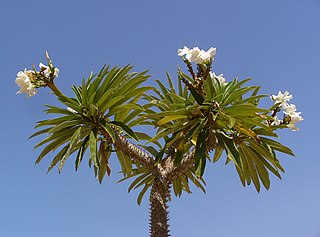
Pachypodium lamerei is a species of flowering plant in the family Apocynaceae. It is a stem succulent, photosynthesizing mainly through its trunk, and comes from the island of Madagascar, off the east coast of Africa. It has large thorns and leaves mostly just at the top of the plant, and large, fragrant flowers. The species has become one of the best known pachypodiums in cultivation, being relatively easy to propagate and grow. In cultivation it is often marketed as the Madagascar palm, despite its not being a palm at all. A variety called "Ramosum" has been described. It is distinguished mostly by a dwarf growth habit and its more rounded corolla lobe.
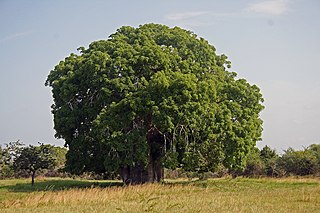
Adansonia is a genus made up of eight species of medium-to-large deciduous trees known as baobabs. They are placed in the Malvaceae family, subfamily Bombacoideae. They are native to Madagascar, mainland Africa, and Australia. The trees have also been introduced to other regions such as Asia. The generic name honours Michel Adanson, the French naturalist and explorer who described Adansonia digitata. The baobab is also known as the "upside down tree", a name that originates from several myths. They are among the most long-lived of vascular plants and have large flowers that are reproductive for a maximum of 15 hours. The flowers open around dusk, opening so quickly that movement can be detected by the naked eye, and are faded by the next morning. The fruits are large, oval to round and berry-like and hold kidney-shaped seeds in a dry, pulpy matrix.
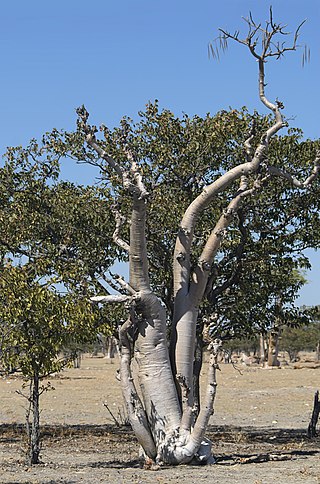
Moringa is the sole genus in the plant family Moringaceae. It contains 13 species from tropical and subtropical regions of Africa and Asia that range in size from tiny herbs to massive trees. Moringa species grow quickly in many types of environments.
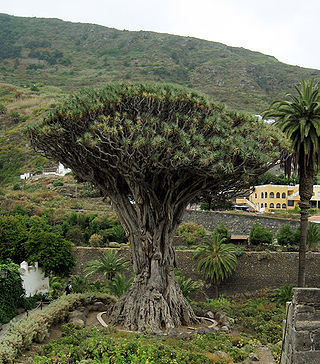
Dracaena draco, the Canary Islands dragon tree or drago, is a subtropical tree in the genus Dracaena, native to the Canary Islands, Cape Verde, Madeira, western Morocco, and is thought to be introduced in the Azores. Its closest living relative is the dragon blood tree of Socotra, Dracaena cinnabari.

Chamaecyparis pisifera is a species of false cypress, native to central and southern Japan, on the islands of Honshū and Kyūshū.

Ravenala is a genus of monocotyledonous flowering plants. Classically, the genus was considered to include a single species, Ravenala madagascariensis, commonly known as the traveller's tree, traveller's palm or East-West palm, from Madagascar. It is not a true palm but a member of the family Strelitziaceae. The genus is closely related to the southern African genus Strelitzia and the South American genus Phenakospermum. Some older classifications include these genera in the banana family (Musaceae). Although it is usually considered to be a single species, four different forms have been distinguished. Five other species were described in 2021, all from Madagascar: Ravenala agatheae Haev. & Razanats., R. blancii Haev., V.Jeannoda & A.Hladik, R. grandis Haev., Razanats, A.Hladik & P.Blanc, R. hladikorum Haev., Razanats., V. Jeannoda & P.Blanc, R. madagascariensis Sonn., et R. menahirana Haev. & Razanats.

Calophyllum inophyllum is a large evergreen plant, commonly called tamanu, oil-nut, mastwood, beach calophyllum or beautyleaf. It is native to tropical Asia and Wallacea. Due to its importance as a source of timber for the traditional shipbuilding of large outrigger ships, it has been spread in prehistoric times by the migrations of the Austronesian peoples to the islands of Oceania and Madagascar, along with other members of the genus Calophyllum. It has since been naturalized in regions in the East African coast. It is also a source of the culturally important tamanu oil.

Moringa oleifera is a fast-growing, drought-resistant tree of the family Moringaceae, native to the Indian subcontinent. Common names include moringa, drumstick tree, horseradish tree, and ben oil tree or benzolive tree.
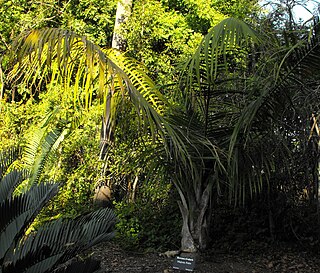
Ravenea is a genus of 20 known species of palms, all native to Madagascar and the Comoros.

Dypsis decaryi is a species of flowering plant in the Arecaceae family. It is commonly known as the triangle palm. It is indigenous to the Madagascan rainforest. Some specimens grow to a height of some 15 metres (49 ft) in the wild. It is relatively new to cultivation however, so outside its native habitat it rarely achieves anything like that height. The leaves are about 2.5 metres in length, growing almost upright from the trunk and arching gracefully outward about a metre from their tips. The leaf bases are arranged in three vertical columns set about 120 degrees apart on the main stem, forming a triangular shape in cross section. This shape has given rise to the palm's common name.
Ravenea musicalis, or the river palm, is a species of flowering plant in the family Arecaceae. Also known by the Antanosy word "torendriky," meaning "submerged trunk", R. musicalis is known for being the only truly aquatic palm tree. Like many mangrove trees, R. musicalis seeds germinate within the fruit, and the seedling takes root underwater. as much as eight feet below the surface. Endemic to Madagascar, R. musicalis was first discovered in 1993 by Henk Beentje on an expedition funded by the McDonald's restaurant. This palm is listed in the IUCN Red List. This tree is harvested by local people primarily for building material and food. Over-harvesting, habitat degradation and habitat loss threaten the remaining populations. Horticulturalists prize R. musicalis for its rarity and unique life history.
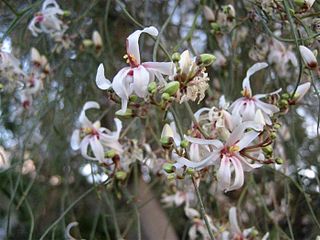
Moringa peregrina is a species of flowering plant in the family Moringaceae that is native to the Horn of Africa, Sudan, Egypt, the Arabian Peninsula, and as far north as Syria. It grows on rocky wadis and on cliffs in drier areas.

In botany, succulent plants, also known as succulents, are plants with parts that are thickened, fleshy, and engorged, usually to retain water in arid climates or soil conditions. The word succulent comes from the Latin word sucus, meaning "juice" or "sap".

Ilex mitis is a tall, dense, evergreen tree that is indigenous to Sub-Saharan Africa and Madagascar. It makes an excellent fast-growing hedge for gardens - growing tall, straight and dense.

Moringa stenopetala, commonly known as the African Moringa or cabbage tree, is a deciduous tree in the plant genus Moringa, native to Kenya and Ethiopia. A drought-resistant species, it is characterized by its bottle-shaped trunk, long twisted seed pods, and edible leaves likened to cabbage, from which its common name is derived. M. stenopetala is extirpated in the wild in Ethiopia, though still grown there as a crop on the terraces of the Ethiopian Highlands, mainly in the Konso region.

Newtonia hildebrandtii, the Lebombo wattle, is a medium-sized tree native to eastern Africa. It is a protected tree in South Africa.




















